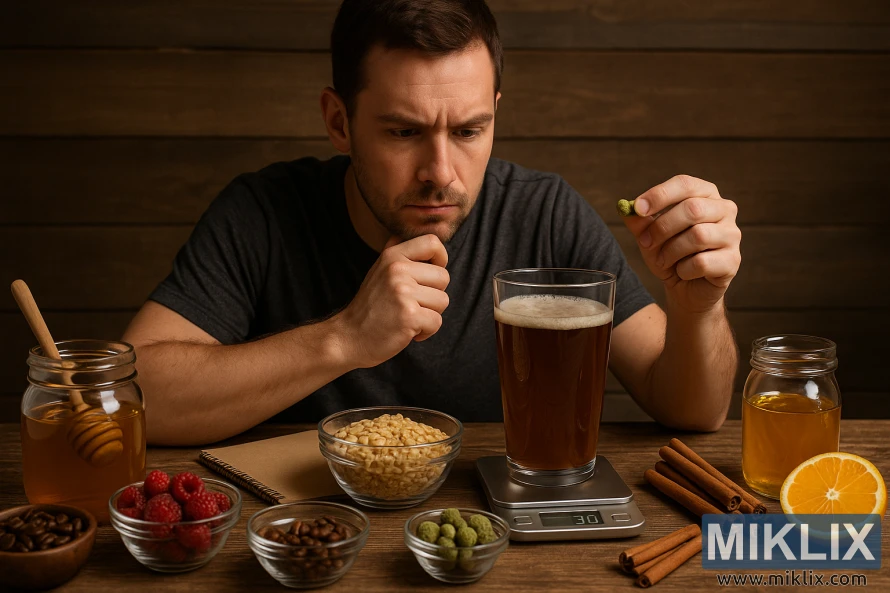Image: Homebrewer Crafting Beer Recipe
Published: July 20, 2025 at 10:59:13 AM UTC
Last updated: September 27, 2025 at 10:21:48 PM UTC
A homebrewer studies a hop pellet, with amber beer on a scale and various adjuncts like honey, coffee, and fruit on a rustic table.
This image captures a moment of quiet intensity and creative deliberation in the world of homebrewing, where science, intuition, and sensory exploration converge. Seated at a rustic wooden table, a man in his thirties—his short dark hair slightly tousled and his neatly trimmed beard framing a face marked by concentration—leans forward in thought. His left hand props up his chin, while his right hand delicately holds a single green hop cone, suspended mid-air as if weighing its potential. His gaze is fixed on the hop, not with casual curiosity but with the analytical focus of someone deeply invested in the outcome of his craft.
In front of him, a pint glass filled with amber-hued beer rests on a digital kitchen scale, its display reading precisely 30.0 grams. The beer glows under the soft, warm lighting, its foam gently settled into a thin ring around the rim. The scale beneath it suggests a meticulous approach—perhaps he's calculating the weight of additions, evaluating density, or simply using the glass as a reference point in his formulation. The presence of the scale transforms the scene from a casual tasting into a moment of technical assessment, where every gram and ingredient is considered with care.
Surrounding the glass is a curated spread of adjuncts, each one chosen for its potential to shape the beer’s flavor, aroma, and texture. A bowl of glossy coffee beans sits nearby, their dark, roasted surfaces catching the light and hinting at the bitter, earthy depth they could lend to a stout or porter. Fresh raspberries, vibrant and plump, add a burst of color and suggest a tart, fruity infusion—perhaps destined for a summer ale or a sour. Green hop pellets, compact and aromatic, are arranged in a separate bowl, their presence reinforcing the central role of bitterness and aroma in the brewing process.
Puffed grains, likely malted barley or a specialty adjunct, offer a lighter texture and a nutty sweetness, while a jar of golden honey glistens with viscous warmth, its wooden dipper resting inside like a tool of both flavor and tradition. Cinnamon sticks lie in a neat bundle, their curled edges and warm brown tones evoking spice and seasonal depth. A halved orange, its juicy flesh exposed, adds a citrusy brightness to the tableau, suggesting zest and acidity that could lift the beer’s profile.
The wooden table beneath these ingredients is rich in grain and patina, its surface worn smooth by use and time. The lighting is soft and directional, casting gentle shadows and enhancing the natural textures of the ingredients and the contemplative expression of the brewer. The background, also wooden, reinforces the rustic ambiance, grounding the scene in a space that feels both personal and time-honored.
Altogether, the image tells a story of brewing as a thoughtful, hands-on endeavor—one that requires not just technical knowledge but a deep engagement with the sensory possibilities of each ingredient. It celebrates the brewer as both scientist and artist, someone who balances precision with creativity, tradition with innovation. Through its composition, lighting, and detail, the image invites the viewer to appreciate the complexity behind each pint and the quiet determination that drives the pursuit of flavor.
The image is related to: Adjuncts in Homebrewed Beer: Introduction for Beginners

